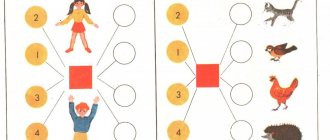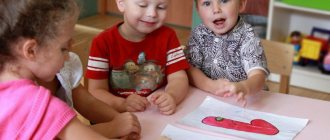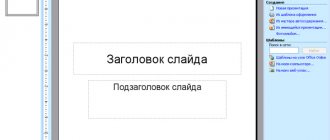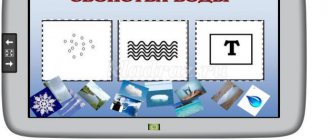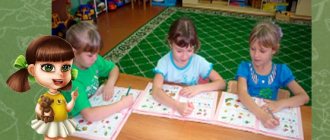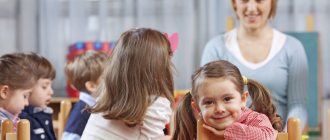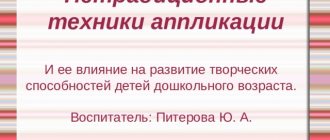card index of outdoor games “Movable Mathematics”
Description: Each player on the team is given one chip - a cap. You need to run to the landmark by completing tasks (bending around the pins, jumping over pigtails), and place the lid on the circle; you only need to put four caps in the circle.
Rules: complete the task quickly, run to the button, put the lid on correctly. The team that completed the task faster and more correctly wins.
Options: five caps per circle, six, seven,...
Relay "Skyscrapers"
Tasks: practice running with a task; consolidate the ability to group objects by a certain quantity.
Equipment: soft rings according to the number of children, 30 cm in diameter.
Description: Each child has a soft ring. You need to twist the ring on your hand, run to the landmark and put the ring in any column (four, five each) as indicated on the cards next to it.
Rules: run quickly, spin the ring without dropping it and place the ring according to the instructions. The team that completes the task faster and more correctly wins.
Relay "More by one"
Tasks: practice jumping and comparing numbers.
Equipment: cards with numbers, two for each child, numbers for the task.
Description: Children are formed into teams, each with a card with a certain number. You need to jump like a snake around the pins, on your left foot (2m), take a card with a number, one more, (according to the task) and jump back on your right foot.
Rules: Jump to the landmark on the left foot, back on the right foot. Be careful in completing the task. The team that completes the task faster and more correctly wins.
Relay "More, Less, Equal"
Objectives: Practice balance, jumping, and comparing sets using a mathematical sign.
Equipment: For two teams: gymnastic board, 4 pcs. braids, 2 pcs. landmark, scoreboard with team numbers - 4.
Description: Children are formed into teams. Each relay participant runs to the landmark on the gymnastics board, jumping over a moat of braids, flips through the board with numbers, stands between them and shows a sign with his hands.
Rule: quickly reach the landmark, having completed the task, correctly show the comparison. Go back and pass the baton with a clap on the hand.
Relay “Your Number”
Objectives: practice jumping on fitballs, consolidate the quantitative counting of objects and correlating it with a number.
Equipment: cards with a quantitative drawing for each child, cards with numbers, fitball - balls, landmarks.
Description: Each player is given cards with a quantitative design (five flowers, one butterfly, three bees,..), each team is given a fitball. You need to jump on the ball to the landmark and take a card with a number that matches your drawing.
Card index of didactic games “Mathematics on a winter walk”
Transcript
1 State budgetary preschool educational institution kindergarten of 51 general developmental types with priority implementation of the artistic and aesthetic development of children in the Kolpinsky district of St. Petersburg Card index of didactic games “Mathematics on a winter walk” Compiled by: teacher of the highest qualification category Morozova T. P.
2 Game: “Find out the length (width) of the path that has been cleared of snow” Objectives: learn to measure length and width using different measurement methods: conventional measures and measuring objects. Material: stick, tape, tape measure, ruler. Find out which road is longer (shorter) Determine which path is wider (narrower) Which snow castle will we get to faster? Game "Where are the objects?" Objectives: to strengthen children’s ability to navigate in space (relative to themselves or a given object) Tell me what is on your right (left, in front, behind) Name what is to the right of the birch tree (from the playhouse, from the sandbox, etc.) Come and stand to the left of the house, etc. Build a snow house to the left of the bench, etc. Game “Winter Mosaic” Objectives: to develop combinatorial abilities, orientation on a plane, creative imagination and design. Material: colored pieces of ice of different colors and shapes, sample cards. Fold a beautiful carpet of ice floes Fold as in the sample Continue the row
3 Game “Find a Surprise” Objectives: to teach how to navigate in space using a site plan. Material: site plan, search toy. Find a surprise from Santa Claus Where the bunny hid Game “Travelers” (“Hike in the winter forest”) Objectives: strengthen the ability to navigate in space, using a plan with a route laid out on it. Cultivate persistence in achieving goals, bringing plans to completion, mutual assistance, and the ability to work in a team. Material: site plan, route plan “Ecological trail”. Game tasks: Visiting the Snow Maiden The road to the magical clearing What first, what then Game “Pathfinders” Tasks: continue to teach how to navigate in space. Introduction to the compass. Material: tables with tasks (algorithmic actions) using the number of steps and the direction of movement according to the compass (for example, five steps to the north, two steps to the east, etc.) Game task: I’ll go there, I know where Determine a place to build a snow fortress
4 Game “Let's decorate a tree with multi-colored pieces of ice” Objectives: development of spatial orientation, auditory attention. Development of creative imagination and design. Material: pieces of ice of different colors and shapes, sample cards for completing the task. Let's decorate the hawthorn bush: at the top there are 2 blue pieces of ice, in the middle - 4 red ones, at the bottom - 3 yellow ones. A beautiful garland (following a pattern or a logical series) Game “Creating a map of a safe winter road” Objectives: continue to strengthen the ability to navigate in space, learn to create a site plan after the experimental game (we measure the depth of the snow cover in different parts of the site) Material: sheet of paper, pencil , conventional measures (sticks) for measuring the depth of snow cover. Game task: Create a road map for a safe trip Game “Construction of a snow town” Objectives: develop constructive abilities. Continue to learn how to navigate in space using a given plan or one created independently. Material: a plan of a limited free area with future objects marked on it, to create a plan - a sheet of paper, a pencil, a ruler, an eraser.
5 Let's build a town for toys Let's invent and build a town for toys Game "Construction" Objectives: consolidate counting and counting skills, correctly complete the task according to verbal instructions. Classification by size. Make snowballs of different sizes Build a fence from snowballs (for example, make 5 large snowballs and 5 small ones and build a fence from them)
The role of the didactic game in the FEMP lesson in the preparatory group
A child is an explorer who discovers the surrounding space for himself. The main goals of educators and teachers are to find an approach and direction to the study of individual subjects.
With a properly set up pedagogical process, children at a young age can effortlessly master the material necessary to study and develop their thinking.
Important! The more prepared a preschooler is, the more successful and understandable his school years will be.
The main problem of our time is efficiency in the development of abilities. Children with high intelligence are able to perceive material better and are more self-confident. Mathematics is of great importance in development. In this subject, thinking develops faster than in others.
The concept of mathematical features consists of the idea of shape, time, and magnitude. These skills serve to develop concepts about life and science.
Mastering the material
Additional pedagogy has a large number of teaching materials. They are aimed at intellectual development.
Card index of theatrical games with goals in preparatory groups
For effective learning of the material, there are didactic games in mathematics in the preparatory group. Their methodology is quite accurately described in the works of E. I. Udaltsova and F. Frebel. The main advantage of these games is training. They stimulate the development of imagination and intelligence, which is the basis of the task of learning.
In a game for children, the main task is to be active, get results, and win.
The main thing for children in a didactic game is gaining new knowledge.
With well-organized training, the level of development of preschool children is determined at the beginning of the year. Then comes the planning of further work:
- identification of interest and creative task;
- development of logic and thinking;
- determining the ability to compare, summarize and analyze;
- identifying abilities to determine mathematical connections.
Taking these components into account, long-term planning is created, the main goal of which is to generalize mathematical concepts.
Types of activities
Using the example of the game “Mushroom Picking” according to E. I. Udaltsova, it is possible to form such connections as “one” and “many”. In this game, children learn concepts such as circle, square, triangle. The main task is to determine the type of figures.
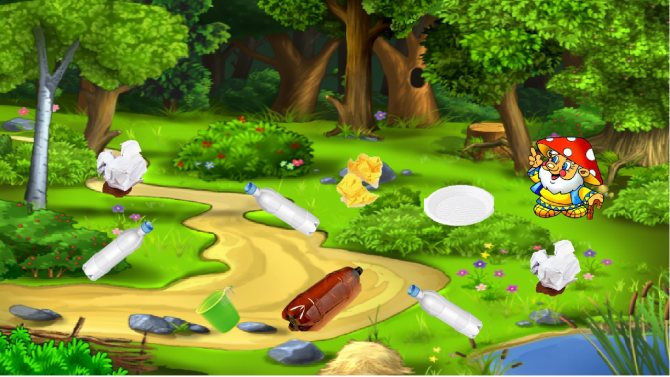
"Travelers in the Forest"
FEMP exercises on the topic “Travelers in the Forest”:
- Age category: middle group.
- Task: correct identification of figures.
- Methodological techniques: conversation, explanation.
Progress of classes:
- Who came to us?
- Bunny.
- He invites us to take a walk in the forest. We'll go to the forest on a train, but we don't have wheels.
- The wheel is a circle.
- We're riding a train through the forest. Fir trees grow in the forest. They come in high and low. You need to show your hands higher and lower.
- Let's move on, stop. There is a chest. It needs a key. The lock is made in the form of a triangle. This means that the key should also be in the form of a triangle.
- There is a small doll in the chest. The doll is sad. Why?
- The doll's beads fell apart. We need to help her collect them all.
- When putting on beads, the guys must name the colors of the beads.
- At the end of the lesson, the guys summarize what they did together.
Mathematics classes with children in the preparatory group
There are 4 reasons why you need to study mathematics additionally:
- preschoolers' education includes subjects that include mathematics;
- additional education makes the study of subjects more understandable;
- Children before school already have an idea of geometric shapes;
- Early teaching of mathematics strengthens children's learning.
Note! Brain research has found that the brain develops faster the more complex the tasks it faces.

Discipline
Children should learn mathematics consciously. The teacher should think and think like a child does. Children cannot divide the world as if it consists of different spheres. They connect everything together.
Children learn through play. It should be remembered that exercise is an additional burden on the body. You need to start consistently, with two classes a week. Next, you need to focus on the student’s reaction.
If a child does not go to kindergarten, then classes are especially necessary for him. Adults should observe what the child is interested in and support his interest in a timely manner. By nature, children are interested in everything. The task of parents is to guide them in the right direction in time.
A clear distribution of free time promotes discipline and creates a tight daily routine. In this case, the desire to watch TV and play online games disappears.
Note! If parents show interest and attention to their children's activities, these activities will pay off in the future.
Objectives and goals of teaching mathematics
General educational goals:
- mastering arithmetic operations;
- initial mathematical development, the ability to compare, observe, analyze;
- understanding of terms and symbols;
- study of oral and written mathematics;
- mastering the mathematical information necessary for studying in primary school.
Educational goals:
- nurturing interest in learning in children;
- development of mathematical abilities;
- aesthetic education;
- recognition of psychological characteristics.
Practical goals:
- developing the ability to use mathematical tools;
- formation of labor skills.
The goals of studying mathematics are enshrined in state standards (FSES). During training, the implementation of goals can occur both in combination and separately. The implementation of the goals depends on the qualifications of the teacher and his ability to convey information.

An example of learning arithmetic operations
Methodology for conducting classes on FEMP in the preparatory group
The methodology for conducting educational activities includes:
- Implementation of existing types of educational activities.
- Application of various forms of child organization. Depends on his activity, independence and interest.
In the development methodology of a preschooler, special attention should be paid to computational activities. Children in Pre-K are given their first ideas about subtraction and addition. Children must learn to draw conclusions and analyze the material received. By understanding the relationship between addition and subtraction, the student should use this to check the correct answer.
Classes must have a structure that is determined by the content of the training and the characteristics of the child’s activities. The lesson has 3 parts:
- entrance;
- lesson process;
- ending.
At the beginning of classes, you should arouse children’s interest, explain how to act during the game, and draw up a lesson plan.
During the lesson, children's mental and practical activities develop. It consists in acquiring new knowledge that is established by the curriculum.
At the last stage, you can determine the level of development of the student. A little help should be given to those children who quickly remember everything. The rest need to be given the opportunity to learn the material and find a way out of the current situation.
Important! It is necessary to strive for every student to achieve results. At the end of the lessons, the results are summed up and the future prospects are determined.
The basic goals of FEMP (formation of elementary mathematical concepts) are the creation of primary ideas about the basic properties of objects.
